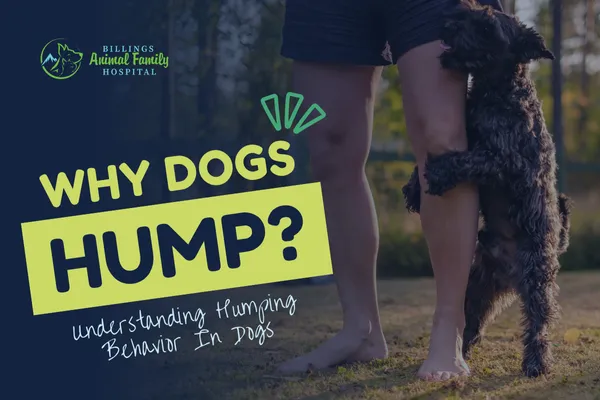
Why Dogs Hump Things | Billings Animal Family Hospital
Why Dogs Hump: Understanding Humping Behavior In Dogs
Have you ever felt uncomfortable when your dog interrupts a peaceful evening by humping a pillow, your leg, or even a visitor? Your pet’s humping behavior, though awkward, is surprisingly common and perfectly normal for dogs. Understanding why dogs hump can help you respond with compassion and clarity.
What You'll Find In This Post . . .
Is humping a problem or just a dog being a dog?
Why dogs hump after being neutered or spayed
How to stop your dog from humping
5. Meet mental and physical needs
Should you ever let your dog hump?
When to talk to a veterinarian or dog trainer
Your dog isn’t weird—just communicating
Common reasons why dogs hump
Contrary to popular belief, dog humping isn't always sexually motivated. Sure, that’s part of the equation especially in intact (non-neutered or non-spayed) pets but there are a variety of reasons why dogs hump:
Excitement or overstimulation: Some dogs hump when they’re overexcited or don’t know how else to release energy.
Stress or anxiety: Mounting can serve as a coping mechanism for anxious dogs. It helps them self-soothe.
Medical issues: Skin allergies, urinary tract infections, or discomfort around the genitals may lead to increased humping.
Social behavior: In multi-dog households, humping can signal dominance, play, or simply mimic learned behavior.
Habitual or learned behavior: If puppy humping was not redirected early, it may become a habit into adulthood.
Is humping a problem or just a dog being a dog?
Occasional mounting is normal, but excessive, uncontrollable humping may indicate deeper issues. Below are some scenarios where this dog behavior may pose a problem.
Compulsive or disruptive humping: Compulsive humping that ignores commands or disrupts life can strain relationships. It is essential to address the underlying causes and manage the behavior.
Humping causing injury: When humping leads to physical harm, it’s a serious concern. Vigorous humping can cause skin irritation or injury, requiring immediate redirection or medical evaluation to prevent harm.
Humping with behavioral changes: When a dog is humping with aggression, fear, or behavioral changes may indicate stress, anxiety, or medical issues, potentially escalating conflicts.
While occasional humping is often harmless, consistent or intense mounting shouldn’t be brushed off. Recognizing when it crosses the line from normal to problematic is key to keeping your pup (and everyone around them) safe and happy.
Puppy humping: Is it normal?
Puppy humping is developmentally normal. Just like toddlers explore with their hands (and mouths), puppies may mount objects, other pups, or your leg. But just because it’s normal doesn’t mean it’s encouraged. It can lead to unwanted habits or social issues later on, so it’s best to gently redirect the behavior early and teach appropriate boundaries.
Why dogs hump after being neutered or spayed
Spaying female dogs and neutering male dogs can stop humping behavior. However, it doesn't go away right after the operation.
Hormones take time to fade. After a neuter or spay, it may take weeks (even months) for behaviors influenced by hormones to subside.
Humping is also behavioral. Once it becomes habitual, dogs may continue even without hormonal drive.
Environmental triggers like stress or boredom can reignite the urge to mount.
Why dogs hump post-surgery has more to do with habit and emotional state than reproductive instincts.
How to stop your dog from humping
The key is to respond, not react when dealing with humping behavior. Reacting with frustration can escalate the situation, while a calm, intentional response helps your dog understand what’s expected.
1. Intervene early
Interrupt early: Learn your dog’s cues, like pacing or whining, and step in before humping starts.
2. Use redirection
Distract and redirect: Offer a toy, chew, or dog training activity to shift their focus.
Redirect play: When humping begins, guide them to another activity like fetch or tug.
Reward toy use: Offer praise or treats when they choose toys over people or furniture.
3. Be consistent
Stay consistent: Allowing it “sometimes” can confuse your dog. Stick to your boundaries every time.
Teach commands: “Leave it” or “Off” can help stop humping early. Use clear cues and reward obedience.
4. Avoid negative reactions
Avoid punishment: Scolding can increase anxiety and reinforce the behavior. Stay calm and redirect instead.
5. Meet mental and physical needs
Mental stimulation: Use puzzle feeders, sniff walks, and brain games to reduce boredom.
Physical exercise: A tired dog is a less humpy dog. Daily play and walks go a long way.
6. Create structure
Social structure: Dogs thrive on routines and clear rules. Establishing boundaries creates a calmer environment where unwanted behaviors naturally fade.
The earlier you guide your dog, the easier it is to prevent excessive humping as they grow. With smart, positive training strategies that build trust and reinforce good behavior, you can shift the habit before it becomes a long-term issue.
Should you ever let your dog hump?
Your dog quietly humping a plush toy at home, may not be a big deal. But if they’re humping people, furniture, or strangers' dogs, especially in public, it’s time to set healthy boundaries.
Here’s a general guide:
Let your dog hump a toy in private if it’s their comfort tool
Interrupt if it becomes excessive or compulsive
Always intervene if it involves another dog, person, or public situation
When to talk to a veterinarian or dog trainer
If humping becomes frequent, aggressive, or obsessive, your best bet is to talk with a veterinarian or certified dog trainer. Here’s when it’s time:
Sudden increase in mounting behavior
Accompanying physical symptoms (licking genitals, urination issues)
Inability to redirect or modify the behavior
Your veterinary team can rule out medical issues, while a dog trainer helps implement effective behavior plans.
Sudden changes in humping or humping with medical symptoms require prompt action. Download our free Emergency Vet Contact Card so you always have vital info at your fingertips.
Your dog isn’t weird—just communicating
Humping isn’t a personality flaw, it’s one of their ways to communicate with you. Whether it's stress, excitement, or leftover habits, understanding why dogs hump helps you respond with patience instead of panic.
Worried About Your Dog’s Behavior? We’re here to help! If your dog’s humping habit has you scratching your head, contact our veterinarian team today for professional guidance and compassionate support.



